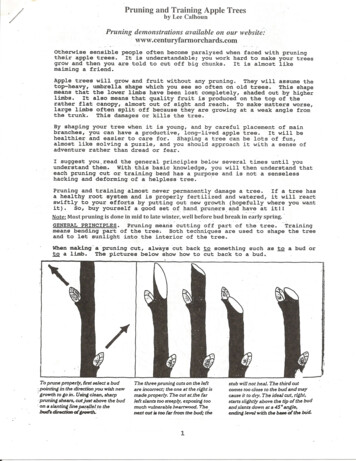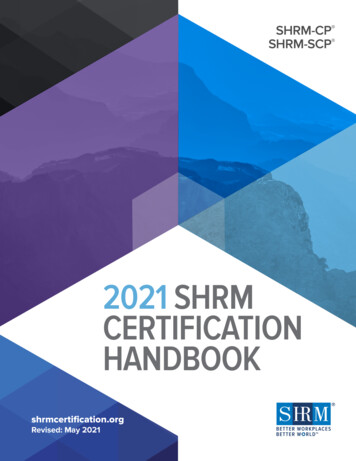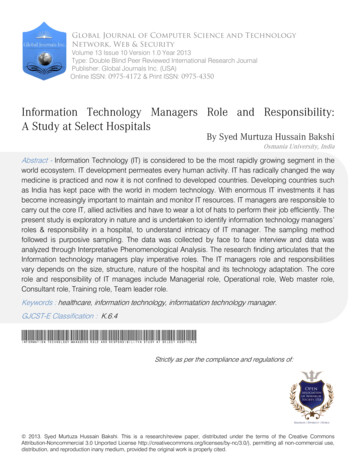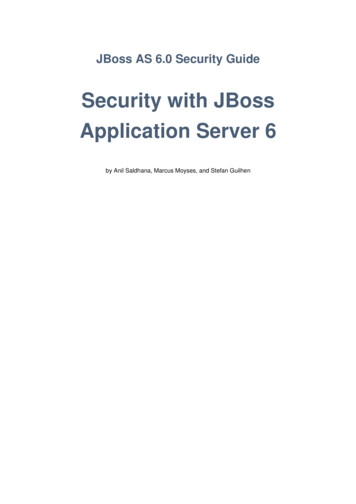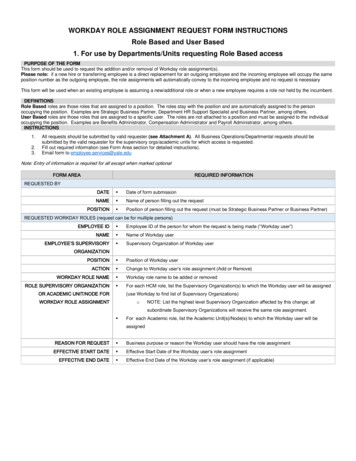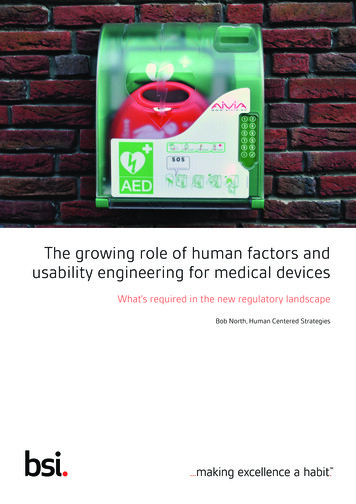
Transcription
The growing role of human factors andusability engineering for medical devicesWhat’s required in the new regulatory landscapeBob North, Human Centered Strategies
The growing role of human factors and usability engineering for medical devices: What’s required in the new regulatory landscapeBackgroundMedical errors have been cited as the cause of nearly 100,000 deaths per year in the US healthcare system by theUS Institute of Medicine in 1994 in its book, To err is human: Building a safer health system. According to the World HealthOrganization’s website, similar trends exist for European healthcare systems, with estimates that 8 to 12 per cent ofhospitalizations involve adverse events and that as many as 18 per cent of patients report having experienced a medicalerror-induced problem. Costs in the UK alone for hospital infection intervention is estimated at 1 million per year.Adverse events over the past two decades have shown disturbing trends in post-market events that are attributable todesign issues regarding the user interface (UI) of medical devices. Infusion pumps, automatic electronic defibrillators,ventilators, and combination products such as drug auto-injectors, have a history of use-related design problemsresulting in overdoses, improper therapy delivery, incorrect diagnoses and dangerous delays in therapy. As part ofthe systematic process to reduce errors by regulatory bodies, medical device companies in the US and EU havebeen introduced to the disciplines of Human Factors and Usability Engineering (HF/UE). HF/UE has been applied inthe automotive, aerospace, and telecommunications industries for more than 60 years, but has only recently beenapplied in the medical industry.HF/UE focuses on the synergy of human operators, or users with systems, and their UIs by applying knowledge ofhuman capabilities and limitations and performing tests and evaluations of user/system performance. Human factorsalso apply known principles and best practices in the design of displays, controls, and other UI aspects to optimizeuse and eliminate or limit use-related risks.Is usability different from human factors? How do theseterms relate?The term ‘usability engineering’, often used as a synonym for ‘human factors’, is also focused on creating qualities ofUIs that result in rapid learning, user satisfaction, and efficient interaction. The term ‘usability’ is a multi-dimensionalquality that refers to the ability of a human to interact easily and relatively error-free with a system or product. Termssuch as ‘user-friendly’ and ‘intuitive’ have emerged as descriptors of usability which translate to subjective attributesregarding whether a system or device works and acts in the way the user expects, therefore avoiding frustration andannoyance in carrying out an intention.What is the impact of usability on healthcare?Usability has a major impact on healthcare, particularly with regard to the overall effectiveness of medical devices.Simply put, if usability is lacking, the completion of user tasks may be slower and more error-prone. Therefore,A child with an inhaler2 BSI/UK/565/ST/0215/en/HL
bsigroup.comdelivery of therapy will suffer and patient safety may be compromised. Moreover, it is well known that easy-to-useproducts are more popular, resulting in market discrimination and a competitive advantage. Therefore, usability canbe a positive attribute from a business and sales perspective as well as controlling risk .How have medical device regulations incorporated HF/UE inregulatory activities?Because of the rising instances of UI-induced adverse events, the US Food and Drug Administration (FDA) has begunto include HF/UE reviews as a routine part of their pre-market approval process at the Center for Devices andRadiological Health’s (CDRH) Office of Device Evaluation. This process is described in a draft guidance issued in June2011 entitled Applying human factors and usability engineering to optimize medical device design.Likewise, the international regulatory community has incorporated IEC 62366, Medical devices – Application of usabilityengineering to medical devices, as a part of the approval process outside the US. Both the FDA HF/UE guidance andIEC 62366 outline a process including activities throughout device development culminating in validation testingwith the final UI design in simulated use environments. In the following sections of this paper, we will summarize themajor expectations of both the international and FDA expectations of manufacturers regarding HF/UE.From the international regulatory perspective, what arethe expected HF/UE outputs requested and reviewed byregulatory organizations?IEC 62366:2007 (BS EN 62366:2008) is undergoing significant revision to provide improved organization andharmonization with the FDA’s 2011 draft guidance on human factors. As a result, compliance with IEC 62366:2007requires evidence of the conduct of a usability engineering process (UEP) which means that manufacturers wouldhave to document their HF/UE work in accordance with the nine clauses comprising the process.Why was IEC 62366:2007 revised?IEC 62366:2007 was revised for several reasons. These were the main motivations for modification:In 2011, the FDA published its own updated HF/UE guidance to the industry. Several important aspects of risk analysisand summative testing were not in alignment between IEC 62366 and the FDA guidance. The new versionof IEC 62366 will reflect a much more synergistic approach with the FDA guidance.Nomenclature differences also existed between US FDA and European terminology regarding usability and human factorswhich have since been resolved.There was a need for more clarity on implementation of the HF/UE process. An ‘informative’ counterpart document wascreated, dividing the standard into the streamlined normative part, 62366-1, and an informative part, 62366-2,which will also be listed as a TR (Technical Report).What are the basic activities in the HF/UE process and what istheir alignment with device risk assessment?HF/UE activities can be categorized into three major phases:1. preliminary analyses;2. user interface design/evaluation;3. simulated use testing (validation). BSI/UK/565/ST/0215/en/HL3
The growing role of human factors and usability engineering for medical devices: What’s required in the new regulatory landscapeThese phases of HF/UE activity align with both the EU and the FDA’s pre-market human factors approval andcompliance requirements described in IEC 62366 and the FDA HF/UE guidance. The relationship of these phases ofHF/UE, in the context of risk assessment and risk management, are shown in Figure 1.Preliminary analysesPreliminary analyses are conducted to identify device user profiles, use environments, and use scenarios. Theseelements are vital to completing a detailed use risk analysis. These three elements are part of both the FDA andIEC 62366 documentation requirements.(a) User profiles are descriptions of user group training, experience, knowledge and potential limitations, such asdecreased visual acuity and manual dexterity. User groups are often differentiated on the basis of what usescenarios they perform, i.e. some users may do different tasks or interact differently than others with the device.This information is vital in determining the composition of user group testing in summative testing with thedevice, and in establishing design requirements to accommodate special needs of certain users.(b) Use environments are brief descriptions of the ambient conditions of the places that the device will be usedincluding parameters such as range of lighting, noise, temperature, and vibration. Other environmental factorsshould be noted, such as distractions or interruptions in the user-device interaction caused by interacting withother devices or personnel in the use environment.(c) Use scenarios are brief descriptions of the sequences of user-device interaction that result in some intendedhealthcare outcome, e.g. initiating delivery of a given drug therapy, altering a previously initiated drug deliveryorder, troubleshooting or responding to alarms. Each use scenario will comprise multiple tasks or steps that canbe further analysed from a use-risk perspective in the use error/use risk analysis.(d) Task analysis is the analytical foundation for several other key activities that are conducted in preliminary analyses,including use error/use risk analysis, user interface design, and formative and summative usability testing. Taskanalysis provides a detailed description of the human requirements to perform the steps required to accomplish ause scenario.(e) Use error/use risk analysis, also a key method in preliminary analyses, should be performed in conjunction withconventional risk analyses to determine specific potential risks of user-device interaction across the use scenarios.Use risk analysis is sometimes referred to as use failure mode effects analysis (U/FMEA) which identifies potential useerrors for each task or step (from the task analysis) that could lead to potential patient or user harm. Such use errorsshould be identified from past history of device interaction, identifying potential confusion or incorrect assumptionsabout how the device works, and by observing user behaviour in formative usability as the UI design matures.Table 1 provides an example of combining task analysis with use error/use risk analysis using a simple blood glucosemeter to illustrate the format of a typical use risk analysis (two columns on the right) based on task analysis (twocolumns on the left).Table 1 – Illustration of task analysis and use risk analysisUser taskPower on meterTask requirementsKnow which button ispower and push for twosecondsPotential use errorsConsequences & risk severityFailure to find button and Delay in knowing status of bloodhold for two secondsglucose (low risk)Set correct time and date Compare setting withtoday’s time/date, usearrow keys to inputsettingsFailure to noticeincorrect time/date orinputting wrong infoThe history of blood glucosereadings, used in setting insulintherapy, will be inaccurate,potentially leading to wrongtherapy decisions (high risk)Check test stripexpirationFailure to notice out-ofdate stripsPotential of 10 per cent error inreading accuracy (medium risk)4Compare today’s datewith expiry date on thestrip vial BSI/UK/565/ST/0215/en/HL
bsigroup.comThe use error/use risk analysis is a complementary process to conducting conventional risk analyses as described inISO 14971, Medical devices – Application of risk management to medical devices, the risk assessment standard for medicaldevices. The challenges of conducting use risk analyses within the scope and intent of ISO 14971 will be discussedlater in this paper.User interface design/evaluationBoth the FDA and IEC 62366 stress the importance of a UI design process that is driven by iterative formativeevaluations. Formative evaluations are usability tests and assessments conducted early and throughout the designprocess. Formative evaluations address two design goals: (a) to make the device interface intuitive and easy to use,and (b) to control or mitigate potential use-related risks. These goals can pose design dilemmas because in someinstances, ease of use and safety may be in conflict. For example, placing the power button for an IV drug deliverydevice next to the start/stop button controlling the infusion may appear convenient, however, the potential of anaccidental shutdown of the device instead of halting the infusion may preclude this convenience, and dictate that thepower button be mounted well away from the start/stop mechanism.Formative evaluation method resourcesAAMI HE75, Human factors engineering – Design of medical devices, Clause 9, Usability Testing, provides an excellentguide to the types of formative evaluations that are useful in early device UI development such as cognitivewalkthroughs, heuristic evaluations, and walk-through-talk-through usability tests. Annex D of IEC 62366 alsoprovides descriptions of these formative techniques.Standards for interface designInterface design standards and best practice references such as HE75 provide excellent guidance for the design ofdisplays, controls, software graphical UIs, alarms, surgical tools, instructions for use (IFU), and other elements of theUIs. However, HE75 stresses the value of iterative user testing during the course of UI design. The role of formativetechniques such as cognitive walkthroughs, heuristic evaluations, and walk-through-talk-through usability tests arevital for obtaining feedback for the design team regarding both ease of use and use error control and mitigation.Different elements of user interfacedesign. BSI/UK/565/ST/0215/en/HL5
The growing role of human factors and usability engineering for medical devices: What’s required in the new regulatory landscapeSimulated use testing (validation)Summative testing (also referred to as simulated use validation testing) of the UI with representative usersperforming a set of use scenarios is the central source of evidence of use safety for both IEC 62366 and the FDAhuman factors pre-market evaluations. To avoid obvious safety concerns to test participants, summative testing canbe conducted under ‘simulated use’ conditions that are representative of real-world conditions.How does summative testing differ from other usability testing?There are several important differences in test methodology regarding summative simulated use tests compared toother usability evaluations such as formative tests listed here:1. The summative test is not meant to be an exploratory effort seeking inputs on design features, but should serveas a ‘final’ demonstration of use safety for the device. Therefore, participants are not interrupted with questions orcorrected in their performance.2. Participants engage in use scenarios chosen to represent sequences of typical interaction with the device. Thesescenarios should cover all tasks that have been categorized as containing high risk in the use risk analysis.3. Training and device familiarization should be provided and represent realistic conditions. This could be doneby conducting a training session prior to testing with an appropriate intervening interval to represent potentialmemory and learning decay.4. Device instructions for use should be available to the participant, but with no requirement to read the instructionsprior to performing the use scenarios, unless the participant chooses to do so on their own.5. User performance on each scenario task (or step) should be observed and categorized with respect to failure,success, and success with difficulties such as hesitation, self correcting of actions, and potential confusion. Theseinstances, along with failures, should be noted for further post-test analysis.6. The summative test should include a post-test dialogue with the study team in order to determine the cause ofany failures and difficulties including both specific questions about particular unexpected or incorrect actions, orgeneral questions about task difficulty during the test.7. Results of the summative test should support an overall conclusion regarding use safety for the device. Thisconclusion should not be based on meeting pre-defined quantitative goals (i.e. 95 per cent success rate acrosstasks and participants), but on whether there is a remaining pattern of use-related problems that are directlyattributable to the UI or accompanying documentation (labelling and instructions, etc.).Insulin, pump, infusion set and reservoir6 BSI/UK/565/ST/0215/en/HL
bsigroup.comAlignment of HF/UE with medical device risk assessmentand managementFigure 1 depicts the relationship with the major phases of HF/UE activities with medical device risk assessment andmanagement. On the left are the phases of HF/UE activities, while the right side shows the stages of risk assessmentand management and how these processes relate to each other.The relationship between the HF/UE process and ISO 14971 risk assessment flow can be summarized as:(a) ISO 14971 identifies an initial ‘risk assessment’ which is characterized by HF/UE preliminary analyses focused onunderstanding users, their use environment, tasks and risks when interacting with the device interface;(b) ISO 14971 calls for ‘implementing risk controls’ which is congruent with the implementation of a device UI that willlimit use risks and testing of that interface for its risk control effectiveness;(c) ISO 14971 then requires an assessment of ‘acceptance’ of the implemented risk controls, which for HF/UE isaccomplished by assessing simulated use testing results for a residual pattern of use errors on critical tasks, anddeciding whether use risk has been controlled to an extent reasonably possible.What are the biggest challenges for device manufacturers inmeeting the expectations of HF/UE regulations and reviewers?The following challenges remain in meeting the intent of the FDA HF/UR guidance and IEC 62366:(a) conducting adequate formative evaluations prior to final design validations;(b) conducting and documenting comprehensive use-risk assessment;(c) the design and interpretation of summative test results in simulated use validation studies.Figure 1 – Relationship of HF/UE process flow with ISO 14971 risk control processConduct preliminaryHF/UE analysesConduct use riskassessmentDesign UI and conductformative evaluationsDesign and implementuse risk controlsNoConduct summativesimulated use testingIs use risk acceptable?Yes‘Device use is safe ’ BSI/UK/565/ST/0215/en/HL7
The growing role of human factors and usability engineering for medical devices: What’s required in the new regulatory landscapeConducting adequate formative evaluationsDespite the modest resources required for formative evaluations and tests, manufacturers often short-circuit theprocess of UI design with little or no formative testing or evaluation. Misconceptions may inhibit the decision toconduct formative evaluations such as:that formatives are too costly and time consuming – Formative studies can be relatively short and conducted Beliefwith a small number of representative users. Conducted early in the design cycle, as few as 8-10 participants canreveal 90 per cent of existing design flaws in the UI that can be modified to eliminate errors and use problems. Asthe UI design matures, formative studies may be employed as trial run tests before conducting the final summativetest, which saves significant time and cost by preventing the need to repeat the summative study due to residualproblems in the interface or the study methodology itself.institutional review board approval causing delays in submissions – Many companies may believe that Obtainingformative tests require elaborate institutional review board (IRB) approval regarding participant safety. Mostusability studies do not present the risk of participant harm (i.e. no therapy is actually delivered because theconcentration is on user interaction with the UI). However, manufacturers may choose to protect themselves fromliability by gaining IRB approval, but this can often take the form of ‘expedited reviews’, given the low complexity ofthe testing compared to clinical trials.testing means more documentation time required – From a FDA and IEC 62366 compliance perspective, the Moreconduct of formative studies does not require extensive documentation in pre-market submissions. FDA reviewersmerely want to know that the manufacturer has conducted iterative tests on the product and has made a besteffort to remove design flaws related to safety. This can be summarized, in submissions, as a table describing thestudy intents and results at a relatively high level. More detail can be provided in appendices if warranted, but thisis seldom asked for by FDA reviewers.Conducting and documenting comprehensive use–riskassessmentThe publication of ISO 14971:2012 has brought welcome rigour to the device risk management assessment process.The standard describes a detailed process of risk estimation based on the combination of subjective estimation ofindividual types of risk severity and probabilities or likelihoods of occurrence of that risk. The product of these twosubjective estimates produces risk priority numbers (RPNs) for a given risk. RPNs give manufacturers a method ofdetermining the overall risk of the device and criteria for acceptance.Estimating likelihood of occurrence is a fairly well-established process for chemical, mechanical, software, andelectrical components because failure probabilities can be determined from laboratory ‘hot bench’ testing. Whenapplied to user/device interaction, this process becomes inappropriate because of the variability and unpredictabilityof human behaviour compared to known electrical and chemical processes.Thus, the FDA draft HF/UE guidance and IEC 62366 use ISO 14971’s flow chart as a foundation for the use riskassessment and management process. Alignment with the ISO 14971 risk assessment process resides in the decisiondiamond labelled ‘Is use risk acceptable?’ (See Figure 1).In place of hot bench tests, observational testing is employed to assess use risk, i.e. summative tests validatingthe final design of the device UI, not a subjective estimation of the likelihood that a user may fail. The ‘acceptance’decision becomes the formulation of a solid argument based on user testing, which is the subject of the third HF/UEmanufacturer challenge described in the next section.The design and interpretation of summative test results insimulated use validation studiesArguably the most challenging aspect of HF/UE implementation is the design, conduct and interpretation ofsummative simulated use test results becoming the major evidence of use safety for a device. These tests of8 BSI/UK/565/ST/0215/en/HL
bsigroup.comrepresentative use with the production level designed UI are somewhat of a departure from conventional usabilitytesting in that the most important aspect is in post-test investigation – determining a root cause of observed failuresand problems.These tests, described in both the FDA HF/UE draft guidance and IEC 62366, are intended to provide an opportunityfor the manufacturer to ‘see’ into the future of the use of the device – a post-market experience. Thus, observationsin these tests that are either unexpected or not desired are investigated in the same manner as an adverse event.We are seeking a root cause of errors occurring in critical tasks that could be mitigated prior to the device beingapproved and marketed.Submissions to the FDA pre-market approval process have generally been required to include summative validationtest results, especially for higher risk devices. Although the quality of these HF/UE tests has improved over time,typical manufacturer deficiencies in conducting and analyzing study results are:using the preliminary use risk analysis to justify testing protocols – The use scenarios that are tested should Notinclude critical tasks from a risk perspective. These critical tasks should be well documented, not left to thereviewer to ‘guess’ why certain tasks were tested. Tables such as Table 2 are a good example of a method ofpresenting your task analysis, use risk analysis, risk control measures and how those tasks were tested/scored inthe summative test.Table 2 – Example of task, use risk, risk control, and testing schemeFunctionTaskPossible useRisk severity/errorsconsequencesDrug delivery Enter volume IncorrectHigh: Patientorder entryof drug to be numeric entries, Overdose (orinfused onincompleteunderdose)keypadentryRisk control in UIdesignSoftware limitsunsafe entries;prompts user tocomplete entry, entryrequires final userconfirmationHow testedSimulateddelivery orderentered andscored foraccuracyjust the success rates without making the overall use-safety case – Many times manufacturers report only Reportingthe testing numbers – 95 per cent of trials showed successful performance, and did not discuss the situations orcauses of the 5 per cent of failure cases. Did that single use error instance in 20 reveal a pathway in which a usercould interact with the device resulting in serious patient harm?‘victory’ from preference results – The use of rating scales regarding ease of use and other subjective Declaringmetrics is not adequate for making the overall use safety case to reviewers. Believing the device is easy to usedoes not equate to demonstration of correct use or a cogent argument to regulatory reviewers.to include the right user groups or enough user groups – The FDA HF/UE guidance and IEC 62366 state that at Failureleast 15 participants should be included from each identified user group interacting with the device. But, how manyuser groups are required? There are two aspects to consider:(a) Who performs the use scenarios?Which user profiles, and so user groups, perform our use scenarios.(b) What are the user characteristics?Any differences in training, background, experience, disabilities or impairments in the user populations maydictate that we test those populations as different user groups. In some cases, especially home use devices andpatient-used combination products, separate user groups for visually impaired or cognitively impaired may berequired. Discussions with the FDA divisions responsible for these reviews may prove beneficial in determiningthe best strategy.to include a time interval between training and testing – For the FDA simulated use test, it is generally Failurerecommended that there be a ‘delay’ between the exposure of the participant to some sort of representative BSI/UK/565/ST/0215/en/HL9
The growing role of human factors and usability engineering for medical devices: What’s required in the new regulatory landscapetraining and the actual test sequence. This is to ‘simulate’ the potential of forgetting key aspects of how the deviceworks, because in the real world use is not likely to immediately follow training. In some combination productsubmissions, the FDA may require a trained and an untrained group.test result failures to ‘human error’ without further justification or argument – Summative test results Attributingshould be analysed on a case by case basis related to observed failures and patterns of difficulties exhibited byparticipants. Merely attributing a failure to ‘participant just forgot’ during execution of a critical task is not a solidargument that the interface is safe to use, as the interface should support the user in all ways possible during taskperformance. Post-test interviews are crucial to making arguments as to whether these instances were actuallytransient lapses in user attention or memory or UI problems. Asking participants why they were confused, whatled them to believe the device worked a certain way or why they made an error is absolutely essential to thisargument process.to test the instructions for use when emphasizing the IFU as a primary means of use risk control – When Failuremanufacturers assert repeatedly that the IFU will be the primary means of controlling certain use risk, the FDA willlikely require some form of specific IFU testing to validate that assertion. This can sometimes take the form of aseparate IFU test, since forcing the participant to use the IFU during simulated use task execution is not realistic.ConclusionsThree main conclusions can be drawn regarding HF/UE:1. HF/UE has become a vital part of the product development process ensuring medical device ease of use and safetyof use. Worldwide, regulatory organizations have begun a systematic oversight and review process regardingmanufacturer compliance with the usability engineering standard, IEC 62366. The FDA pre-market device reviewprocess now routinely includes human factors risk assessment and validation testing of the device UI withintended users.2. HF/UE activities should be conducted throughout all phases of device design and development includingpreliminary task and risk analysis, UI design and evaluation, and final summative validation testing in simulateduse.3. The HF/UE process should be aligned with the overall device risk management process for the device. Finaldecisions regarding use risk acceptability should be based on the results of simulated use testing withrepresentative users evaluating the presence of any remaining patterns of failures and difficulties on tasks withcritical risk implications.Resources and referencesDraft Guidance for Industry and Food and Drug Administration Staff – Applying human factors and usability engineeringto optimize medical device design, FDA Center for Devices and Regulatory Health, June, 2011Medical device use-safety: Incorporating human factors engineering into risk management, FDA Center for Devices andRegulatory Health, July, 2000AAMI HE75:2009, Human factors engineering – Design of medical devicesIEC 62366:2007, Medical devices – Application of usability engineering to medical devicesISO 14971:2007, Medical devices – Application of risk management to medical devicesWeinger, M. B., Wiklund, M. E. and Gardner-Bonneau, D. J., Handbook of human factors in medical device design,CRC Press, 2010Kohn, L.T., Corrigan, J.M. and Donaldson, M., (eds.), To err is human: Building a safer health system, (Washington DC,National Academy Press, 2000)10 BSI/UK/565/ST/0215/en/HL
bsigroup.comBSI is grateful for the help of the following people in the development of the white paper series.AuthorBob NorthDr North has been involved in the application of human factors in the design of products and systems for over thirty five yearsfor aviation, military, and medical systems. After managing the Human Factors group at Medtronic’s Cardiac Rhythm Managementgroup, he founded his own consulting firm in 2003, Human Centered Strategies helping device manufacturers achieve FDAcompliant Human Factors processes for pre-market approval. Dr North is
2011 entitled Applying human factors and usability engineering to optimize medical device design. Likewise, the international regulatory community has incorporated IEC 62366, Medical devices - Application of usability engineering to medical devices, as a part of the approval process outside the US. Both the FDA HF/UE guidance and



